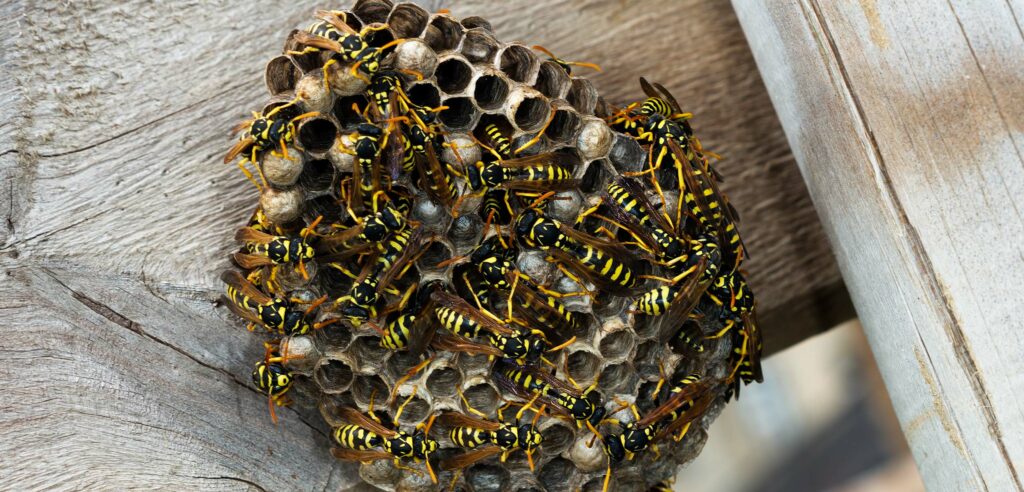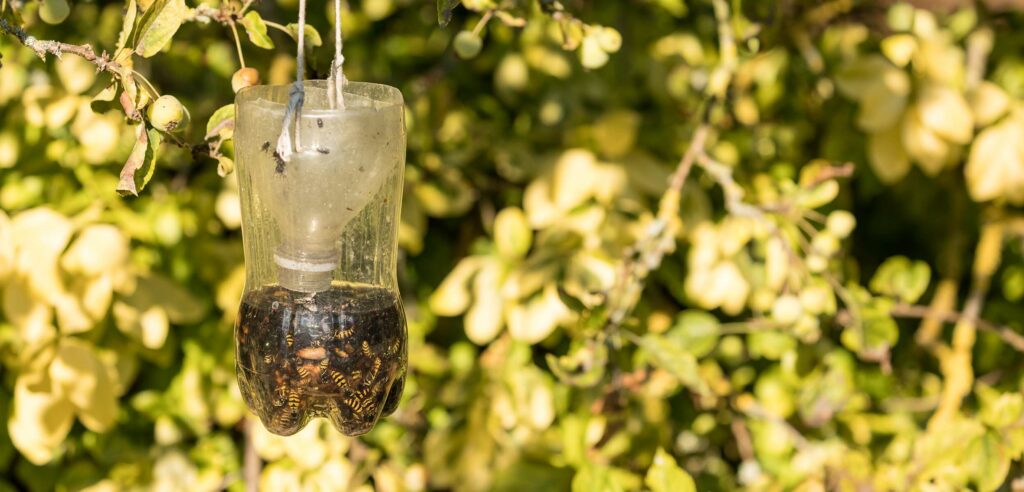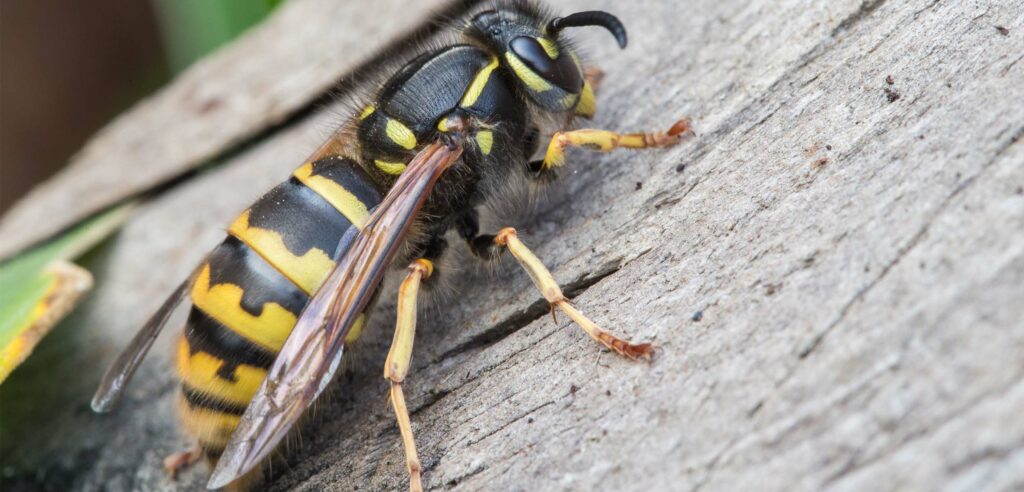Summertime is supposed to be the season you can enjoy the outdoors and relax on the porch with a cold glass of ice tea. But in California’s welcoming climate, annoying wasps can ruin the fantasy!
If you’re looking for advice on how to keep wasps away from your porch and property, keep reading for professional tips. We’ll discuss why wasps are attracted to your property in the first place and what you can do to help prevent wasps from making themselves at home.
If you’ve got wasp nests outside (or inside!) your home, it’s a problem that deserves your attention. Dustin Pest Control is Central California’s leader in pest management and wasp removal.
Give us a call to whisk away wasps, hornets, and other unpleasant bugs before they start nesting on your porch, deck, or anywhere else you like to soak up the sun.
Are Wasps Really a Problem?
Yes. Most wasps socialize and spend their lives in colonies. This means that a few stray wasps are likely to encourage more wasp activity and can even lead to entire nests being built. Jumping on the problem early is the best way to prevent colonies from settling on your property.
Those bugs buzzing around your front porch may not be bees. Here are some popular wasp pests in California:
● Yellowjacket wasps, marked by their bright yellow and black stripes. These wasps are social and aggressive. They will nest underground or in raised spaces.
● Paper wasps are brown or black in color and will usually build nests under shelter, such as a porch ceiling.
● Hornets are larger than wasps, very social, and will swarm when provoked. Hornets like to nest near trees or wood structures.
Wasps Will Sting You and This Sucks
If you’ve been stung by a wasp you know how uncomfortable it can be. Not to mention that some people have allergies to wasp stings.
While most wasps are only typically aggressive when provoked, coexisting with them peacefully can be a challenge. Your regular activity around your home, garage, or porch may be perceived as a threat to the colony.
Cohabitating with wasp nests is not a pleasant experience, especially if you have small children. Getting ahead of the problem will make wasps feel unwelcome from the start.
Wasps Can Damage Wood & Building Materials
Just like termites, wasps and hornets like to chew through wood. Some species use this wood pulp as a building material for their nest.
This means that wasp colonies and nests are a risk to the structural integrity of your home. This could mean chewing a hole in your home’s exterior which can lead to leaks and moisture problems, or damage your roof soffits.
So keeping wasps away from your living area is about more than just peace of mind. It’s about keeping your family, and your home, safe from these pests.

Why Are Wasps Attracted to Your Property?
Wasps find your home attractive for the same reasons you do: it’s warm, comfortable, protected from the wind and sun, and there’s lots of food available! Knowing what wasps love about an adopted home is important for understanding how to steer them away.
Here are some reasons that wasps might nest and reproduce in your roof, porch, yard trees, or garage.
Gimme Shelter
Wasps want to stay protected from the sun, wind, and predators while they’re dormant. One of the best ways to do this is by finding nesting habitats that shelter them from all these things. Unfortunately, our human homes are full of places where wasps feel comfortable and protected.
Under soffits, eavestroughs, and raised decks are all ideal places for a group of wasps to start building their nest. Trees with less exposed branches can also be ideal for wasps to hang.
Your Home is Giant Buffet for Wasps
Keeping a colony fed right requires lots of food! And a human home full of food and drinks is a paradise for wasps looking to stock up on calories.
Proteins and sugars are wasp faves. So they’re going to be attracted to your BBQ area, backyard tables, drink stands, and anywhere else you cook or place food. Wasps are also intrigued by smells coming from inside your home through open windows and doors, or cracks and holes in the exterior.
Wasps are going to seek out and hover around:
● Any exposed human food or drinks
● Fallen fruit from trees
● Empty soda or alcohol bottles
● Hummingbird feed
Wasps Love Flowers Too!
Wasps are sugar fiends and this applies to natural sugars too. Flower nectar contains a considerable amount of sugar, so pretty gardens will attract wasps. The smell of flowers and other floral fragrances (such as perfume) can also draw wasps to your personal space.
How to Stop Wasps From Getting Comfortable
If you’ve got an existing infestation of wasps, it’s best to call professional pest control experts to solve the problem. But there are several things we encourage you to do as part of your summer routine if you live in a wasp-friendly climate.
Hang Wasp Traps and Have No Mercy
Trapping wasps is one way to stop them from flying about while you’re having dinner outside. Wasp traps contain a liquid that attracts wasps and hornets. Trap designs prevent these pests from escaping once they’ve been lured by the flavor chamber.
Hang traps close to your home, but not right at entrances or right near eating areas. These traps should have a lot of wasp activity, so you want them to be placed strategically. Close enough to where wasps normally hang out on your property but not right beside normal walkways.

Make Some Home-Made Wasp Traps
Dustin Pest Control wasp removal pros will set you up with the most effective wasp traps for your problem. But you can create home-made traps with this technique:
1. Cut the top off a large, empty, plastic soda bottle.
2. Fill the bottom with some soda or juice (full of sugar!).
3. Add a few drops of liquid dish soap. This will kill wasps when they consume it.
4. Invert the top of the bottle and place it back in the bottle.
5. Place the traps near wasp activity.
These makeshift traps should entice wasps to enter and make it tricky for them to escape. If you’ve got live wasps in your trap, be careful when moving or disposing of your DIY wasp trap.
Spray Wasp Nests
If you’re waiting on your local pest control expert, you can spray wasp nests and colonies in the meantime. There are several wasp sprays in the market, choose one that gives you a little distance with a powerful nozzle.
Spray wasp nests in the evening. Wasps are more dormant at this time and you may kill more of them. Avoid spraying if wasps seem agitated or there are lots of wasps buzzing around.
A homemade mixture of liquid dish soap and water will also suffice. Use 2-3 tablespoons of soap and spray liberally.
Call a Professional Pest Expert
Pssst…we’re experts at removing wasps and turning your outdoor living areas into bug-free havens. When wasps are taking over your property, the most-stress free solution is to let a professional do the work.
A Dustin Pest Control specialist will assess your wasp problems, let you know what our strategy is, and go ahead removing wasp nests and eliminating wasp activity in and around your home.
Give Em’ the Natural Treatment
Turn wasps off from potential nesting areas by treating these surfaces with essential oils. A combination of clove, geranium, and lemongrass will deter wasps from hanging around.
You can spray these oils in areas that seem wasp-worthy like under porch ceilings and in protected corners of your home’s exterior. You can also wipe an oil-soaked cloth in these spaces.
Be Smart About Your Garbage
Your residential garbage is full of sugars and other yummy wasp food. Make sure that garbage is being thrown out immediately during wasp season. Empty bottles left outdoors and garbage bags that aren’t totally sealed will keep wasps swarming about.
If your home is vulnerable to wasp activity, invest in sealed hard plastic or metal garbage containers. Make sure that garbage bags are placed inside and that the lid is sealed tightly after use.
Don’t Leave Food Out
Food scraps such as chicken bones or fruit peels are like filet mignon for a hungry wasp. You’re going to save yourself from being annoyed, and possibly getting stung, by disposing of food scraps immediately after eating.
BBQs and other outdoor areas where food is prepared should be sealed tight and cleaned regularly. Wasps will smell this food and hover around. Make sure to clean eating surfaces regularly, ideally after each meal. Even leftover crumbs or a drink ring from your soda is enough to beckon these wannabees.
Seal Cracks & Holes in Your Siding
Wasps can smell the food you’re cooking indoors, too. Make sure that open windows and doors have screens to prevent wasps from entering your home. But cracks in your siding and exposed entries to your home can also be gateways for wasps.
If wasps can actually nest inside your walls, this is like the Beverly Hills of bug real estate. Sheltered and protected from the elements and predators, but easy access to fly out for a night on the town.
Make sure to seal open cracks and holes around door frames, window frames, in your siding, and in places where air conditioning and other equipment connect with your home’s interior.

We Make Sure Pesky Bugs Buzz Off
During the spring, summer, and fall, wasps are going to want to make themselves at home on your porch, deck, or roof. Keeping the things they love like sugar and protein away from open areas will help prevent wasps from buzzing around.
Treat areas that wasps love with essential oils and spray wasp nests once you first notice they’re being built. And keep your outdoor furniture and cooking equipment clean to keep wasps disinterested.
We’ve never met a wasp colony we couldn’t whoop at Dustin Pest Control. Our wasp removal strategy is also about eliminating these pests and preventing them from coming back. Get in touch with our friendly team for professional help that will keep wasps away.


